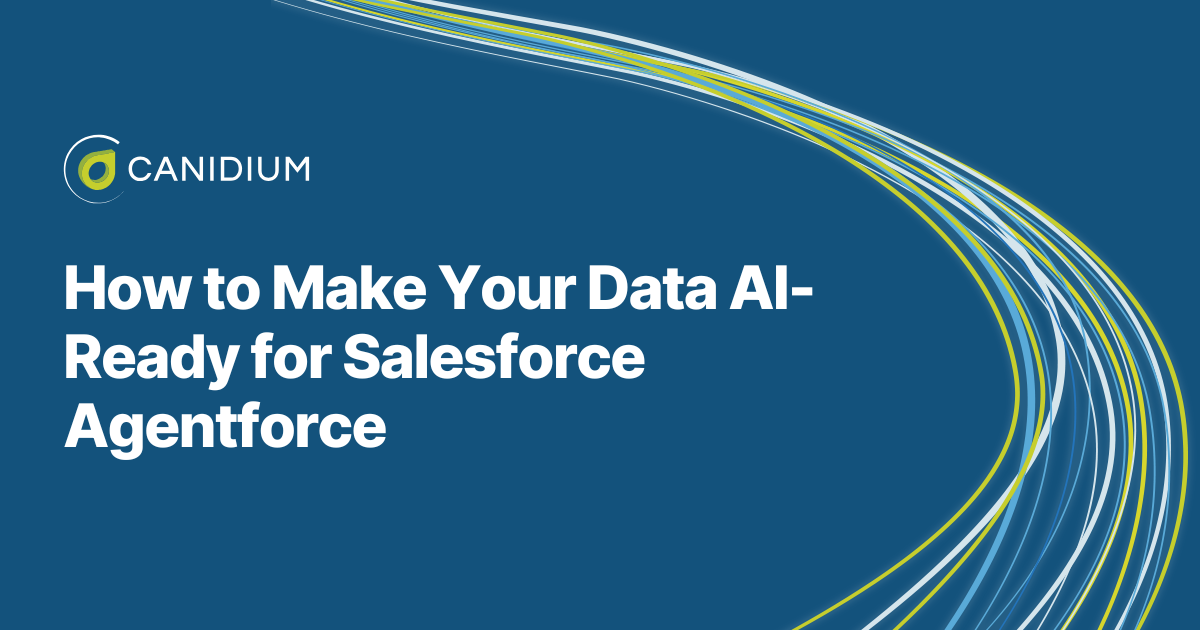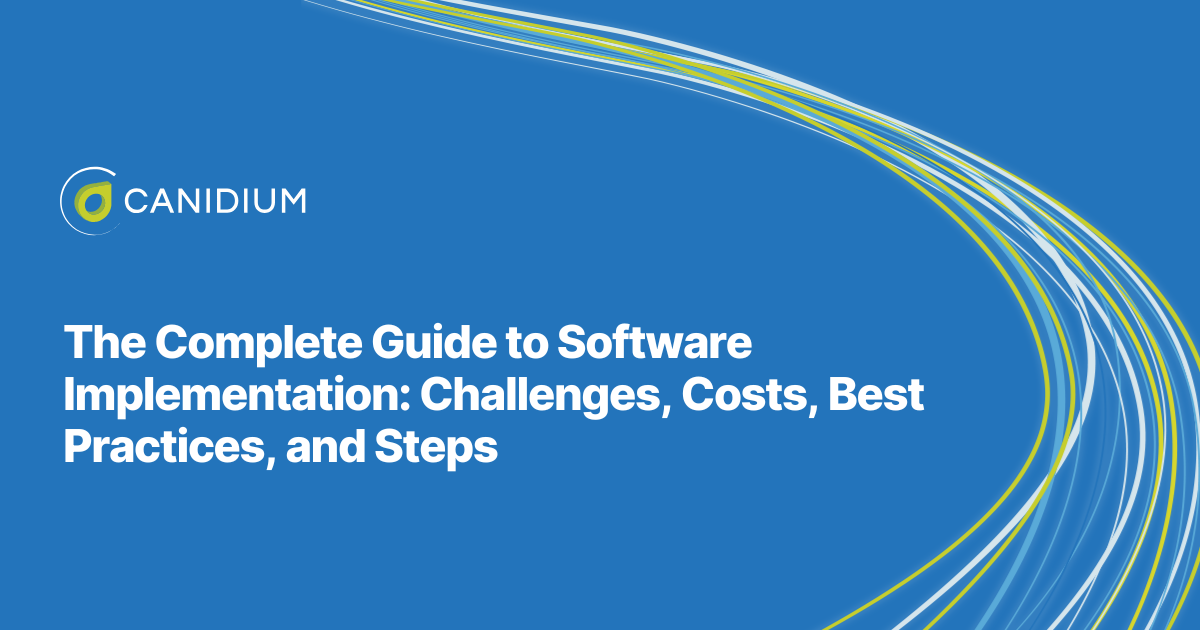Pricing software is still relatively novel, but it is quickly becoming a practical necessity for enterprise and mid-level businesses. In fact, 44% of high-growth businesses leverage pricing dashboards.
Tools such as Pricefx offer extensive potential revenue growth and profit margin expansion without the need for operational scaling and its associated costs. Yet, that said, the process of implementing a pricing software solution is still complicated, and the ultimate returns you will see from the project depend on how well it is executed.
At Canidium, our pricing solution implementation team specializes in designing, configuring, implementing, and maintaining best-in-class partner solutions. We have extensive experience overseeing pricing software implementations, allowing us to guide organizations through the nuances of their project.
This article is the first installation of our project experts’ 8 part guide to implementing pricing software. It highlights the five essential roles that are crucial for a successful pricing software implementation, outlining their unique contributions and the reasons they are indispensable to the project.
The Step-By-Step Guide to Successfully Implementing Pricing Software
This series is designed to meticulously unfold the complexities of pricing software implementations. Our approach provides a clear roadmap from the project outset, introducing each crucial phase in detail, making it easier to absorb and apply the information effectively. This article represents the first installment in the series, setting the foundation by discussing the essential roles required for a successful implementation.
Over the course of this series, we will cover the following topics:

5 Roles You Need for a Successful Pricing Software Implementation
Implementing pricing software is a substantial undertaking that requires more than just technical know-how; it demands a comprehensive understanding of both the software's capabilities and the strategic business objectives it supports. To ensure a successful deployment, a specific set of roles must be filled by individuals who can provide the necessary leadership, expertise, and operational support. These roles are critical not only for the technical aspects of implementation but also for aligning the project with the company’s financial and market positioning goals.
From managing complex integrations to ensuring the software aligns with business strategies, the following roles form the backbone of any successful pricing software initiative. Whether you're a small business or a large enterprise, understanding these roles will help you assemble the right team to maximize your investment in pricing technology.
.png?width=1920&height=1080&name=Pricing%20Software%20Implementation%20Project%20Success%20Factors%20(1).png)
1. A Project Manager to Oversee the Price Management Software Implementation Team
Implementing price management software can often parallel the complexities of an ERP-level project, where the intricacies of integration, multiple stakeholders, and large volumes of data converge. This is where the pivotal role of a project manager comes into sharp focus. A project manager not only orchestrates the operational aspects of the project but also ensures alignment and synchronization across various departmental functions—critical factors that can significantly impact the success or failure of the implementation.
Navigating Complexity in ERP-Level Pricing Software Implementations
ERP-level implementations are always challenging y due to the extensive coordination required among different business units and stakeholders. When deploying price management software, the challenges are similar, involving detailed processes that integrate closely with existing ERP, CRM, and data lake applications. A seasoned project manager with experience in ERP systems is not just a benefit but a necessity. They bring a nuanced understanding of how to manage the expectations and contributions of diverse teams—from pricing strategists to product marketing specialists.
The Risks of Inadequate Coordination
Without effective cross-departmental coordination, projects can quickly get stuck due to internal delays and lack of coordination.. Scheduling conflicts, differing priorities, and communication breakdowns can become significant barriers to progress. For instance, consider the implications if key personnel are unavailable when crucial decisions or validations are needed. The project manager plays an essential role in ensuring that all parties are not only informed but also available to deliver on their responsibilities at the right times. This involves a delicate balance of strong leadership and diplomatic negotiation, especially when resources are shared across departments that also need to maintain their regular operational outputs.
The Critical Role of a Strong Project Manager in Price Management Software Implementations
The cornerstone of successful project management in pricing software implementation lies in the ability to manage and mitigate the risks associated with complex projects. A good project manager understands that their role extends beyond mere administration; it's about fostering a collaborative environment where each team member understands their role and its impact on the project's overall success. This requires a project manager to have both a macro and micro view of the project, ensuring that everything from the overarching project goals to the minutiae of daily tasks is aligned with the strategic objectives.
Additionally, a project manager must adeptly manage the time of all involved, often negotiating with department heads to secure dedicated blocks of time from key team members. This is crucial because most team members will have ongoing responsibilities outside of the project. For example, a project manager needs to clarify whether a team member who is allocated 50% to the project is available consistently for half the week, every week, or if their availability might fluctuate significantly. Establishing clear, predictable schedules is essential for maintaining project momentum and meeting critical milestones.
2. Subject Matter Experts (SMEs) and Pricing Leaders to Build in Pricing Strategies
In the complex ecosystem of a software implementation, Subject Matter Experts (SMEs) and pricing leaders play a crucial role. These professionals are deeply entrenched in the day-to-day operational aspects of pricing within a company. Their direct involvement in the development and testing phases of the project not only ensures that the software functions technically but also that it aligns perfectly with the company's strategic pricing objectives and ways of working
On-the-Ground Insight and Pricing Strategy Development
SMEs and pricing leaders possess an intimate understanding of the intricacies involved in pricing strategies and processes. Generally, positioned just below the VP of Pricing or Pricing Director, these professionals are the gears that keep the daily pricing operations moving. Their responsibilities encompass a detailed operational knowledge, which includes knowing the specific tasks that must be accomplished and how they tie into broader business objectives.
This hands-on experience makes SMEs and pricing leaders invaluable to the pricing software implementation process. They are typically closest to the product marketing and sales teams, which allows them to effectively bridge the gap between the technical solutions provided by the software and the practical needs of the business. At the same time, they have detailed insights into the customer base and the sales cycle; knowledge which can be configured into the solution to enable real-time pricing capabilities that drive up profit margins without deterring target customer segments. Their everyday interaction with pricing mechanisms positions them perfectly to forecast potential issues and provide actionable insights that can steer the project toward success.
Critical Role in Pricing Software Testing and Validation
One of the most significant contributions of SMEs and pricing leaders is their role in testing the new pricing software. Given their comprehensive understanding of existing pricing procedures, strategies, and market segments, they are adept at evaluating the software from a practical, operational standpoint. This testing goes beyond mere functionality checks to include validation of the software’s effectiveness in real-world scenarios, thereby pinpointing the optimal price to capture more potential customers while also improving profit margins.
These professionals ensure that the software not only works in a test environment but also performs efficiently when deployed fully within the business's operational framework. Their feedback is crucial for adjusting the software to better meet the company's needs, often catching issues that may not be apparent to those not involved in day-to-day pricing activities.
Bridging the Gap Between Technical Solutions and Business Objectives
By leveraging their detailed knowledge and firsthand experience, SMEs and pricing leaders act as the critical link between the IT department implementing the software and the business units that will use it. Their role is to communicate necessary customizations and feature requests that align the software with the company’s pricing strategy and market conditions. This collaboration is essential for ensuring that the software provides tangible benefits and supports the company’s objectives effectively.
3. A Product Owner to Determine Pricing Solution Priorities
In the implementation of pricing software, the role of the Product Owner is critical. As the visionary and strategic leader, the Product Owner is tasked with setting priorities that align with the business’s overarching pricing goals. This role is not just about managing tasks; it’s about steering the project towards strategic success by making pivotal decisions about what gets done and when.
Defining Pricing Software Project Priorities and Vision
The Product Owner, typically a Pricing Director or VP of Pricing, is responsible for outlining the project's roadmap. They determine the critical "must-haves" for the software’s initial phase and ensure that these essential features align with the business's immediate needs and long-term goals. He or she has the vision and knowledge of what features are going to bring the most value to the organization, either through increased revenue and margin or through operational efficiency. These choices might involve deciding whether to prioritize price setting capabilities, quoting functionality, or contract management features in the early stages of implementation.
This leadership is crucial because there is often more work envisioned than can realistically be accomplished within the initial timelines set for going live. The Product Owner's ability to discern which elements are essential for the early phases—and to defer others until later stages—ensures that the project maintains a focus on delivering value incrementally, yet effectively.
Strategic Leadership in Pricing Structure and Feature Development
Once the initial priorities are set, the Product Owner’s role extends into the sprint planning and execution phases. They are deeply involved in refining the details of each feature during the development sprints. This involves a continuous cycle of assessment and adjustment to ensure that the software development aligns with the evolving needs of the business.
The Product Owner is instrumental in starting the project off with a solid foundation by focusing on the most critical aspects first. This strategic input is vital for ensuring that the team does not stray into less important features too early in the process, which can dilute the impact and effectiveness of the implementation.
The Catalyst for Cross-Functional Collaboration
Beyond just setting priorities, the Product Owner serves as the key liaison between the IT development team and the business side of the organization. They must effectively communicate the business’s needs to the technical team and ensure that the software developed meets these requirements. This role is essential for bridging the gap between technical possibilities and business expectations.
The Product Owner also plays a pivotal role in managing stakeholder expectations throughout the organization. By keeping the project aligned with the business’s strategic goals and clearly communicating progress and setbacks, they help maintain organizational support and enthusiasm for the initiative.
4. IT Support and Lead to Configure the Pricing Software
The configuration of pricing software within an organization's existing IT infrastructure is a complex task that requires detailed knowledge of both Enterprise Resource Planning (ERP) and Customer Relationship Management (CRM) systems. The IT support team, particularly the IT lead, plays a pivotal role in ensuring that the pricing software integrates seamlessly with these systems, which is essential for accurate pricing and efficient order management.
Integrating with ERP and CRM Systems With Pricing Software
ERP systems like SAP form the backbone of many organizations' operational frameworks, managing everything from inventory and logistics to pricing and billing. A deep understanding of how these systems manage pricing is crucial for the IT team as they configure the new pricing software to work within established parameters. This ensures continuity in effective pricing strategies across the organization.
Similarly, integration with CRM systems, such as Salesforce, is vital for managing customer-related data. CRM systems often handle opportunity management and customer interactions, which directly influence pricing decisions. The IT lead must understand not only the technical specifications of these systems, including their range of features, automation capabilities, and integrations but also how they interact with pricing modules to provide accurate and timely pricing guidance to sales teams.
The Role of Data and Integration Specialists in Pricing Model Developement
The integration process is highly data-intensive, requiring precise handling of data transfer and synchronization between systems. This is where the expertise of IT professionals who specialize in data integration comes into play. They are proficient in ETL (Extract, Transform, Load) processes, which are fundamental for migrating data between systems without loss or corruption.
These specialists ensure that data flows smoothly from the ERP and CRM systems to the new pricing software, maintaining data integrity and operational continuity. Their role is critical during the requirements and discovery phase, where they help outline the data and integration architecture that will support the pricing software. This foundational work is essential for building a robust system that enables data-driven decision making.
Collaboration and Technical Expertise
Successful implementation of pricing software requires close collaboration between the IT team and other departments, such as pricing management and sales. The IT lead, often accompanied by a small team of specialists, must work closely with these departments to understand their needs and expectations from the pricing software. This collaborative approach ensures that the pricing optimization software is tailored to the organization’s specific operational requirements. Moreover, inter-departmental coordination ensures the final product has a user-friendly interface, thereby increasing solution adoption and subsequently facilitating more data-driven pricing decisions during critical phases of the sales cycle such as contract negotiations.
The IT team’s responsibilities extend beyond the initial integration. They are also involved in ongoing maintenance and troubleshooting, ensuring that the system continues to function correctly and adapts to any changes in the business environment or IT infrastructure.
5. Executive Sponsors to Spearhead the Price Optimization Software Project
The success of any significant technological initiative, such as the implementation of price optimization software, often hinges on the support and leadership provided by executive sponsors. Typically holding positions such as Vice President, CFO, or Head of Sales, these C-level executives play a crucial role as the main champions of the project. Their involvement is pivotal not just for the approval and launch of the initiative but also for navigating the challenges that arise during its execution.
Role and Influence of Executive Sponsors
Executive sponsors are more than just figureheads for a project; they are actively involved in defining its scope and objectives, ensuring that it aligns with the organization’s strategic goals. Their deep understanding of the company's vision enables them to guide the project in a direction that maximizes its impact and ROI. Moreover, these sponsors are instrumental in fostering a culture of support and enthusiasm around the new system, which is critical for gaining buy-in across all levels of the organization.
Decision-Making and Pricing Software Project Problem Resolution
One of the key responsibilities of an executive sponsor is to facilitate decision-making processes that may affect the project's timeline, budget, or quality. They possess the authority to make high-level decisions quickly, which helps in maintaining the project's momentum. Furthermore, executive sponsors are crucial in resolving blockers or challenges that could derail the project. Whether these are technical issues, budget constraints, or interdepartmental conflicts, the executive sponsor’s ability to intervene effectively can keep the project on track.
Bridging Cross-Departmental Efforts
Executive sponsors also ensure that the price optimization software project does not operate in a silo. They promote collaboration across different departments, such as IT, sales, and finance, which is essential for the holistic integration of the software into the business processes. By facilitating communication and understanding between these groups, executive sponsors help to align diverse departmental goals with the project objectives, ensuring a cohesive approach to price optimization.
Supporting Dynamic Pricing Change Management
Implementing new software often requires significant changes in pricing processes and workflows. Executive sponsors are vital in managing these changes, as they help communicate the need and benefits of the new system across the organization. Their endorsement of the project reassures employees and encourages them to embrace the new technology, which is critical for successful adoption and utilization.
How to Maximize Revenue With Your Pricing Software Project Team
The implementation of pricing software goes beyond the mere integration of new technology; it requires a strategic assembly of key roles that bring together technical acumen and business insight. The five critical roles outlined—Project Manager, Subject Matter Experts (SMEs), Product Owner, IT Support and Lead, and Executive Sponsor—each play a pivotal part in ensuring that the pricing software not only integrates seamlessly with existing systems but also supports and enhances the company's strategic objectives. Their collective expertise ensures that the project remains aligned with the company’s financial goals and market positioning, thus guaranteeing a successful implementation and optimal return on investment. Understanding and filling these roles effectively is essential for any organization looking to leverage pricing software to its fullest potential.
To learn more about increasing revenue with advanced software solutions, read this guide to using pricing software and sales team performance management solutions in tandem.








